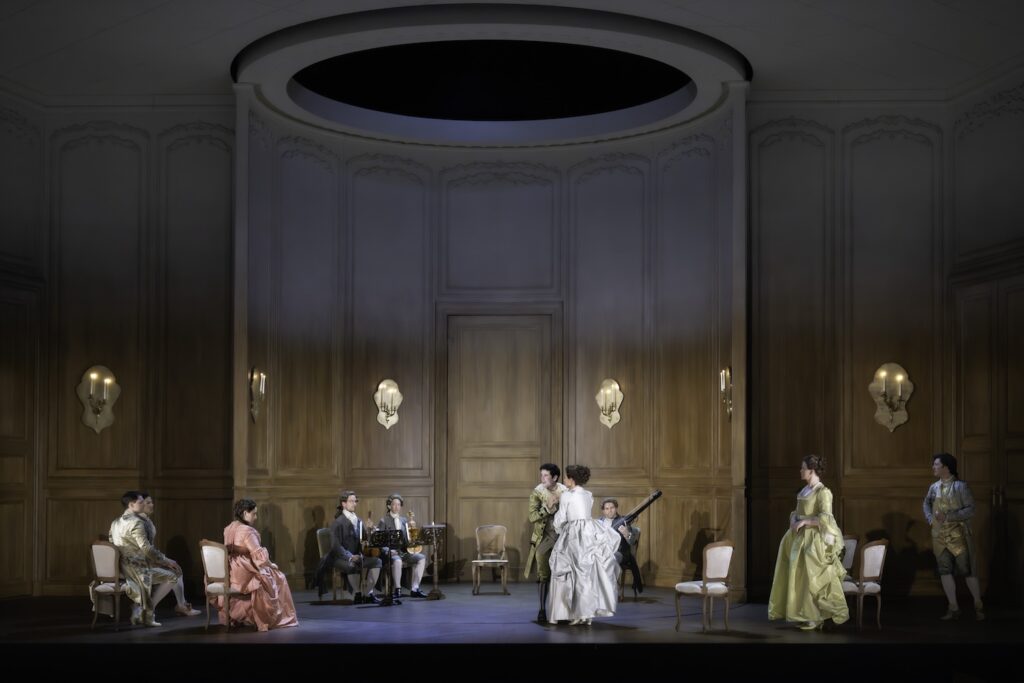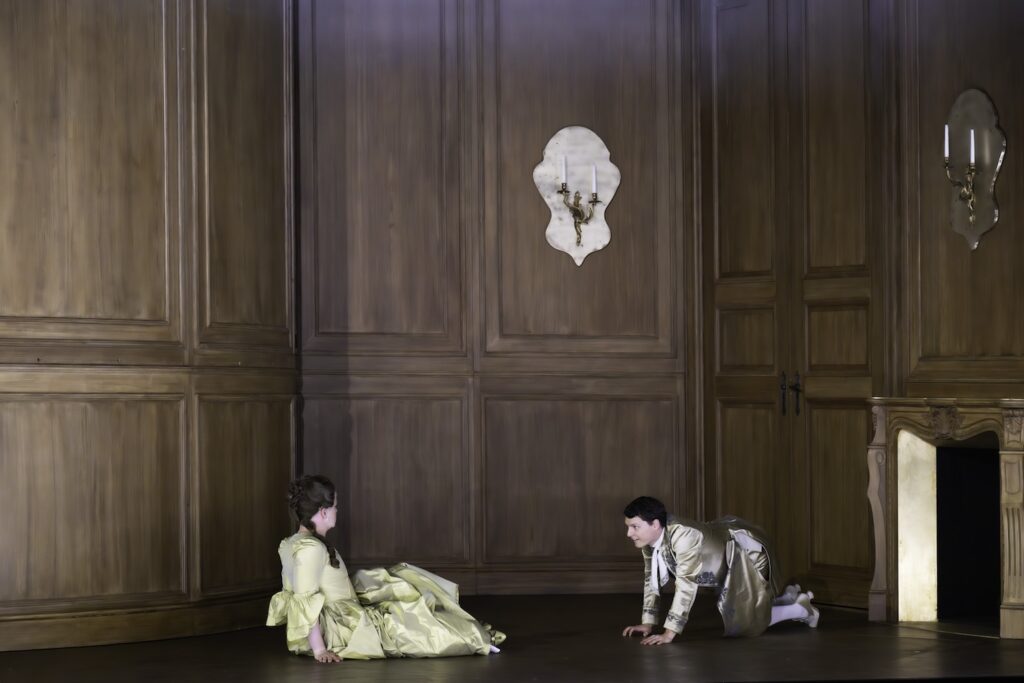Dutch stage director Jetske Mijnssen transferred Francesco Cavalli’s whimsical 1651 comedy La Calisto from its native Venice to France, one hundred years later — 1751, where the arts of an enduring Rococo spirit had lost their lightness, gained symmetrical rigidity, and assumed a turgid, judgmental stance.
According to Mlle. Mijnssen. No need to argue.
We faced, for three and one half hours, a spartan salon of epic proportions, its unadorned boiserie (wood covered walls) interrupted in the exact center by a revolving stage, one side a gigantic door, the other side a soaring domed, circular spaced that was dressed in various ways to effect changes of location. It often turned. Set design is credited to German born, London-finished Julia Katharina Berndt.
In the pit of the Tréâtre de l’Archeveché was the French Baroque Ensemble Correspondances, an ensemble founded by conductor Sébastien Daucé to perform the music of France’s Grand Siecle, i.e. that of Louis XIV. For this La Calisto Ensemble Correspondences was comprised of 35 players, a number hard to imagine sitting in front of the stage at Venice’s tiny, scrappy Teatro Sant’Apollinare during Venice’s famed Carnival, back in 1651. Tthough it was a number of players easily imagined sitting in Versaille’s theater in 1751 during the reign of Louis XV.
In the program booklet the Aix Festival’s dramaturg, Timothée Picard, informs us that French society was quite decadent back then, an idea that stage director Mijnssen evidently shared with or imparted to Mr. Picard, as the inhabitants (Jupiter, Mercury, Juno, Pan, et al) of this grand, pre-Enlightenment salon were quite obviously domesticated, wearing the very latest in mid-eighteenth century period costume design, credited to London based Hannah Clark. They knew the steps to all of the latest late-Baroque dances, swankily choreographed by Austrian dancer/choreographer Dustin Klein.

The story was fairly directly told often in somewhat amusing terms, given the histrionic and vocal abilities of the production’s Jove, American bass Alex Rosen. Jove falls for the pretty nymph Calisto who has pledged herself to the goddess Diana’s cult of virgins (who love one another). So Jove disguises himself as Diana who meanwhile has fallen madly in love with sleepy Endimione. Juno gets the lay of the land, and has Calisto disfigured. Jove is powerless to restore her beauty so he transforms her Into a starry constellation..
Except in Mlle. Mijnssen’s production Calisto, now in her celestial glory, stabs Jove dead in some sort of twenty-first century feminist revenge, though Mr. Picard argues, not very convincingly, that it is a just death for a selfish blowhard.
As performed in Aix, it didn’t add up to a corrupt, lascivious society, as much as a descent into a silly comedy of manners — Mlle. Mijnssen’s 21st century idea of 18th century manners that might amuse jaded opera-goers. This demanded a very matronly Juno, well impersonated by Italian mezzo-soprano Anna Bonitatibus, though Mme. Bonitatibus was unable to command the stage vocally in her big, second act moment of revelation, nor for that matter did she succeed as the prologue’s Eternità.
The star of the show was definitely bass Alex Rosen’s Jupiter, who found a convincing, amusing if not beautiful falsetto for his extended scenes as the contraband Diana. Mr. Rosen gamely portrayed a grandiose drag queen (lead photo, right), greatly relieving us when he returned to his fun loving Jove personage in his fine-toned, quite beautiful bass voice. It was a total performance.
The real Diana was played by Italian mezzo-soprano Giuseppina Bridelli, now a well-known interpreter of the Baroque repertory, once a participant in the Aix Festival’s young artist program. French mezzo counter-tenor Paul-Antoine Bénos-Djian, also a former Aix young artist played Diana’s lover Endimione, who gave us a beautifully sung, sleepy seduction of Diana in remarkably fine, mezzo voice.
La Calisto was convincingly portrayed by young French soprano Lausanne Oliva (lead photo, left). Of the clear voice required by Baroque Opera she easily held the stage, fulfilling with some panache the demands of a title role.

The well-matched cast was completed by American tenor Zachary Wilder in the travesty role of the nymph Linfea who reveals Diana’s romantic dalliance, Linfea herself rejecting the advances of Satirino, played by French soprano counter-tenor Théo Imart, exhibiting an amazing access to the full soprano range.
Bolivian baritone José Coca Loza as Silvano, Texas tenor David Portillo as Pan joined Linfea to give a sound beating to Diana’s lover Endimione. Mercurio, Jove’s facilitator, was effectively played by British baritone Dominic Sedgwick.
Ensemble Correspondences, to Maestro Daucé’s baton, turged on throughout the evening, in mostly dark colors, though Cavalli’s sinfonias came forth with grandiose, French orchestral pizazz. There was a bit of strange, fancy, groovy non-period solo drumming as the curtain fell on the first part of the evening (Satirino was about to tell Pan that Diana loves Endimione — dot, dot, dot).
It was a long, very long evening.
Michael Milenski
Théâtre de l’Archvêché, Aix-en-Provence, France, July 12, 2025
All photos © Monika Rittershaus, courtesy of the Aix Festival